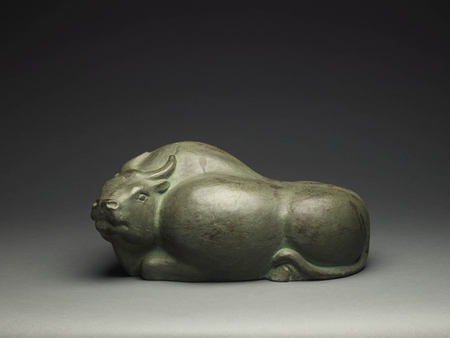Product Description
7056 A bronze okimono (decorative object) in the form of an ushi (bull)
Signed: Yūma
Japan 20th century Taishō/Shōwa period
Dimensions: H. 7½” x W. 15 x D. 9½” (18.5cm x 38cm x 24cm)
Tomobako inscribed: Yūma saku (Made by Yūma)
Seal: Yūma
Tsugata Yūma (1891-1981) Born in Ishikawa he entered Tokyo University of Arts in 1912 and studied under Asakura Fumio (1883-1964). He first exhibited at Nitten (The Japan Fine Arts Exhibition) in 1920 where he won first prize and went on to become one of the most representative bronze artists of the Shōwa period. Tsugata is also well known for his ceramic works and in 1938 he became manager of the Ishikawa Prefecture Ceramics and Crafts Office. He specialised in sculpting animal, Buddhist and human figures. A great many of his works decorate temples and other sites throughout Japan including the bronze bull entitled Tenjinushi (lit. heavenly bull) at the Ueno Gojo Tenjin Shrine and the Yumeushi (lit. dream bull) at the Hanibe Gankutsuin temple, Ishikawa prefecture.
Images of ushi (bull/ox) and related animals have been used in Japan since the 8th century for talismanic purposes. Ushi are believed to ward of smallpox and even today religious ceremonies occur which involve the appearance of both daemons and oxen, the supposed instigators of disease. Ushi are also associated with Sugawara Michizane (845-903), the 9th century aristocrat later worshiped as the god of calligraphy and more commonly known as Tenjin.







